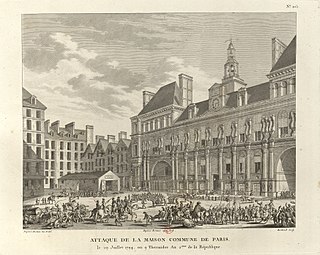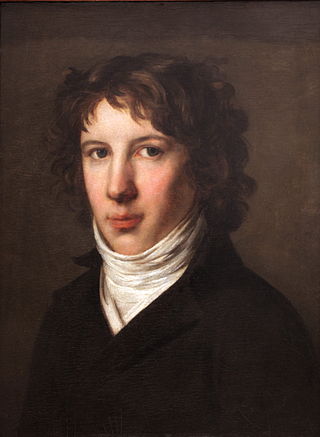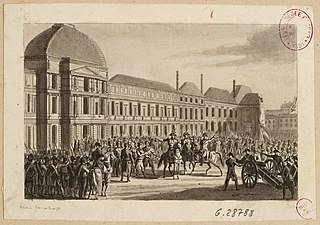Adoption
On 2 June 1793 after an insurrection and the fall of the Girondins the National Convention chose Louis Saint-Just and several other deputies to serve on a committee that would draft a new governmental system for the recently established Republic. The new constitution was intended to supersede the Constitution of 1791, which had been based on principles of constitutional monarchy that were now obsolete after the execution of King Louis XVI. The draftsmen were also placed on the elite Committee of Public Safety to maximize their resources. The Convention deemed their work to be of supreme importance, to be completed "in the shortest possible time." [4]
The work took eight days. [5] A complete constitutional document was submitted to the convention on 10 June 1793. [4] It was subsequently accepted by that body on 24 June and put to a public referendum. [6] [7] Employing universal male suffrage, the vote was a resounding popular victory for the new constitution, which received the approval of 1,784,377 out of approximately 1,800,000 voters. [8]
The Constitution expanded upon the Declaration of the Rights of Man and of the Citizen of 1789, to which it added several rights: it proclaimed the superiority of popular sovereignty over national sovereignty. It added several new economic and social rights, including right of association, right to work and public assistance, right to public education, right of rebellion (and duty to rebel when the government violates the right of the people), all written into what is known as the Declaration of the Rights of Man and Citizen of 1793.
Contents
Sections 1 through 6 spelled out exactly who should be treated as a French Citizen and under what conditions citizenship could be revoked. All males over the age of 21 who worked, owned land or other property in France, lived in France for over a year, or had family ties to a French person, or those specifically named by the legislative body would be considered citizens. Citizens sentenced to corporal or dishonourable punishment, or who had accepted offices or favors "which do not proceed from a democratic government" would lose their citizenship, which could be suspended if you were under investigation or being held in contempt of court.
Sections 7 through 44 specified the sovereign powers of the People, the Primary Assemblies, the National Representation, of the Electoral Assemblies, and of the Legislative Body. The Primary Assemblies were to comprise between 200 and 600 people, each representing an individual canton, who would vote to accept laws proposed by the Legislative Body, select deputies to the National Representation, and select electors to the Electoral Assemblies. The Constitution made explicit that representation would only be determined by population, not by groups (as in the Estates-General, in which each Estate had its separate representation). In the case of a tied vote in the National Representation, the oldest member would supply the tie-breaking vote.
Sections 45 to 52 laid out specific procedures to be followed by the Legislative Body, specifying a quorum of 200 members.
Sections 53 to 55 specified what issues are matters of law, while 56 through 61 establish the path for a bill to become a law. After being drafted and approved by the Legislative Body, the law would be considered a "proposed law" and voted on by all of the communes of France. No debate was to occur until 2 weeks after this distribution, and the bill would become law provided that no more than 1/10ths of the communes voted to voice objection to the law.
Sections 62 to 74 dealt with the Executive Power, which was to be placed in the hands of a 24-member executive council appointed by the Electoral Assembly. These members were to appoint agents to high administrative offices of the Republic.
The Constitution prescribed the relationship between the Executive Council and the Legislative Body, the governing of the Municipalities. It also established the conduct of the Civil Justice System, mandating that arbitrators be elected and that citizens could select arbitrators for their case, and of the Criminal Justice System, mandating trial by jury and representation for the accused. It specified that no citizen would be exempt from taxation and established regulations for military leadership and conduct and foreign relations.
Article 109 stated: "All Frenchmen are soldiers; all shall be exercised in the use of arms." [9] From the moment of its acceptance, it was made meaningless, first by the Convention itself, which had been charged to dissolve itself on completion of the document, then by the construction of the working institutions of the Terror. Condorcet, the main author of the first draft, was accused of federalism and had to go into hiding in early July. [10]
The Constitution declared that France was a "friend and ally of free nations", would not interfere with the government of other nations and would harbor any refugees from "nations ruled by tyrants". It also forbade the establishment of peace with an enemy that occupied French territory.
Finally, it guaranteed the right to equality, liberty, security, property, the public debt, free exercise of religion, general instruction, public assistance, the absolute liberty of the press, the right of petition, the right to hold popular assemblies, and the "enjoyment of all the Rights of man". It declared the Republic's respect for "loyalty, courage, age, filial love, and misfortune". Illegitimate children were recognized. [12]
On 4 August the French Constitution of 1793 passed through the Convention. [lower-alpha 1] At the end of August rebellious Marseille, Bordeaux and Lyon had not accepted the new Constitution. According to French historian Soboul, Robespierre was against the implementation before the rebellious cantons had accepted it. [14] By mid-September the Jacobin Club suggested that the Constitution should not be published, on the argument that general will was missing, although an overwhelming majority favoured it. [15]

















